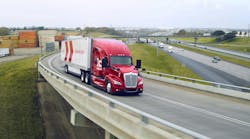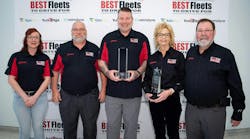If you think light-truck owners are willing to sacrifice to get better fuel economy, think again. Bigger engines cranking out more horsepower and low-end torque remain the norm for pickups and vans. Manufacturers are also continuing to build up payload, cargo-carrying and towing capacity, while offering bigger, more refined cabs that are being packed like never before with a wide range of technology such as onboard navigation systems.
“That's because the commercial customer is always looking at the total value equation, not this piece or that piece,” explains Dan Tigges, product manager-fleet and commercial, for General Motors. “It's not just about fuel economy: it's also about purchase price, cost of operation, safety, resale value, reliability, durability, power and performance, along with a host of other issues.”
“Obviously, reliability is at the top of the list; it's the price of admission to the commercial side of this market,” says Dave Gutman, commercial truck sales and marketing manager for Ford Motor Co.
Joe Veltri, director of truck product marketing for Chrysler LLC, agrees. “These truck and vans are tools for the commercial customer, so uptime is very important; uptime is how they make money,” he says. Low cost of ownership runs parallel to uptime, Veltri adds, since minimizing dollars spent on maintenance helps maximize business profits over the life of the vehicle.
Capability and versatility are also key factors, notes Gutman. Fleets want a choice of chassis and cab configurations to fit their specialized vocational needs. “Everyone wants greater vehicle productivity and efficiency — the ability to do more with one vehicle in one trip,” he says. “Instead of needing two vehicles to run materials and personnel to a job site, they want that carrying capacity married to a super crew cab so they can get it all done with one truck.”
But light trucks are more than business tools. They're also becoming mobile offices, requiring more interior storage, electrical power and data links for paperwork, laptop computers and information downloads into navigation systems, says Orth Hedrick, Nissan's product manager-light trucks.
“We're finding that smaller fleets especially need storage not only for work tools, but paper files, computers, cellphones and recharging capability for the latter two,” he notes. “We've created a lot of interior writing surfaces within our Titan pickup to offer light-truck users the workspace for their office-related needs.”
MORE EFFICIENT POWER
That doesn't mean light-truck makers are ignoring fuel economy. Far from it. “Once gasoline and diesel crested $3 a gallon, our world got far more complex,” says Ford's Gutman. “We've all been engaged in a torque war of sorts…but now we must find ways to reconcile that need for power with fuel efficiency.”
GM, for example, is using active fuel management (AFM), along with 6-sp. transmissions, to improve the fuel economy profile of the Vortec 5.3L and 6.0L V8 gasoline engines powering its Chevrolet Silverado and GMC Sierra pickups. Depending on driving conditions, fuel economy is up by as much as 12%.
AFM automatically deactivates half of an engine's cylinders in low-demand situations — idling in rush-hour traffic or cruising on flat highways, for example — and reactivates them when full power is needed. According to GM, this saves fuel over the complete duty cycle of the vehicle.
Ford is also tinkering with its light trucks, to gain fuel economy without sacrificing power or capability. The OEM is eliminating energy waste in every vehicle system, including power steering, cooling and electrical, as well as minimizing wind drag through design and optimizing its new 6-sp. transmission, says Derrick Kuzak, group vp of global product development
The company's F-250 Super Duty team has been able to increase fuel efficiency by more than 1 mpg by reducing aerodynamic drag and optimizing gearing. “While we are implementing our near-, mid- and long-term plans, we are continuing to achieve efficiencies throughout the vehicle in areas that can quickly lead to fuel economy improvements today,” Kuzak stresses.
“We continue to make improvements in what we call the ‘1%’ areas — items such as reducing wind drag, eliminating engine-driven power steering pumps and switching to low-friction engine oil,” he says.
Chrysler retooled its gasoline-powered 5.7L HEMI V8 so it provides more horsepower (380) and torque (404 lb.-ft.) than previous models; it can now go from zero to 60 mph in 6.1 seconds. In addition, fuel economy has been increased by about 4%. “Fuel economy has always been important, as commercial users are driving a lot more miles,” says Veltri. “But they certainly don't want fuel efficiency to impede on vehicle capability.”
Despite a higher price, diesels are still the engine of choice for most commercial light-truck users, he says, because they combine maximum power with good fuel economy. “They give you more capability in terms of towing and hauling, better fuel economy and longer service intervals. They also hold their resale value better; it's not unusual to get 75% of the value back at resale.”
Typically, light-duty diesels have only been available in the 3/4- and one-ton pickup segment. In Chrysler's case, it's a 6.7L Cummins turbo-diesel that meets 2010 standards in all 50 states. But Veltri says Chrysler is looking to roll out a 1/2-ton diesel option after 2009. The new engine will provide a dramatic increase in low-end torque, up to a 25% improvement in fuel efficiency and a 20% reduction in carbon dioxide emissions when compared to an equivalent gasoline engine.
Toyota is also jumping on the diesel bandwagon, with plans to upgrade the Tundra with a diesel option starting around 2010, says Sona Iliffe-Moon, spokesperson for Toyota Motor Sales.
The availability of diesel engines has helped spur growth in the light-duty van segment, most notably with the Sprinter and GM's Savana and Express models. Ford is jumping into this market next year with its Transit Connect, which has proved popular in Europe.
“There's a burgeoning market among small business owners that need a smaller vehicle for primarily inner-city operation, not the 14,000-lb. chassis of our E-Series,” says Ford's Gutman. “It combines good fuel economy with high maneuverability and cargo room, which will help us fill some holes in our light-duty commercial product lineup.”
Ford boosted the Transit's capabilities in Europe last year by offering a new Durashift 6-sp. transmission combined with a 2.2L Duratorq TDCi diesel engine on front-wheel-drive (FWD) models for the first time, says Christine Lund, chief program engineer-commercial vehicles for Ford in Europe.
“A lower load floor for easier loading and unloading, a larger load space with extra interior height, and outstanding maneuverability are all attributes that customers recognize in our FWD option,” Lund says. “Our new 6-sp. transmission retains all of these vehicle attributes while delivering up to 10% better fuel economy and more comfortable cruising.”
GM has added a variety of enhancements to its Savana and Express vans for the 2008 model year to make them even more efficient for commercial users. A beefed up Gen IV small-block V8 engine family offers more power for gasoline versions, along with a whole raft of new standard features, according to Greg Bilski, product manager for vans.
Those features include a tire pressure monitoring system; four-wheel antilock disc brake system with hydroboost; dynamic rear proportioning; StabiliTrak; driver and front-passenger air bags; and daytime running lamps. “We brought the 6.0L Duramax diesel engine option to the van segment in 2006,” Bilski notes.
THE RIGHT TOOL
The Dodge Sprinter's 3.0L common-rail direct injection (CDI) turbodiesel, in addition to its 3.5L V6 gasoline engine, has proven to be a mainstay for light-duty commercial customers, says Mike Accavitti, Chrysler's director for Dodge brand & SRT marketing and communications. With 600 cu. ft. of capacity, maximum payload of 5,649 lbs., a low side step-in height of 19.9 in., seven feet of interior roof height, a rear-door opening of 270 deg., and pallet-friendly cargo sliding door loading width of 51 in., the Sprinter is “ideal” for inner-city operations, adds Veltri.
“We've sold every single Sprinter we can get our hands on without a single dollar of incentives because it's designed to meet the commercial customer's needs,” Veltri notes. “FedEx, UPS and DHL are all using it because it's simply the right tool for this segment. Commercial customers tend to be extremely loyal buyers; once they get something that works for their operation, they stick with it. All we have to do is keep enhancing that product to better fit their needs and address new ones as they develop.”


